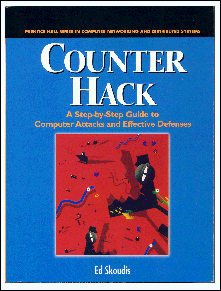Book Review

Counter Hack
A Step by Step Guide to Computer Attacks and Effective Defenses
Ed Skoudis
Prentice-Hall Series in Computer Networking and Distributed Systems, 564 pages (2002)

|
 t is a pleasure to finally find a 'hacker book' that not only contains useful
information, but is actually well-written.
The book starts out with obligatory background chapters on
TCP/IP, Unix, and Windows NT/2000, then devotes a chapter to each
phase of an attack, including reconnaissance, port scanning, gaining
access, maintaining access, and covering tracks. The coverage is
logical without drowning the reader in OS-specific details, emphasizing
the attack from the hacker's point of view.
t is a pleasure to finally find a 'hacker book' that not only contains useful
information, but is actually well-written.
The book starts out with obligatory background chapters on
TCP/IP, Unix, and Windows NT/2000, then devotes a chapter to each
phase of an attack, including reconnaissance, port scanning, gaining
access, maintaining access, and covering tracks. The coverage is
logical without drowning the reader in OS-specific details, emphasizing
the attack from the hacker's point of view.
As with many trade paperback computer security books, however, this
book also contains some errors.
For example, on page 111 it says that password salting makes the Unix
passwords more secure. This is not so: last time I checked, in Unix
the 'salt' was included as the first two characters of the password
string. Indeed, if the salt were not saved in the clear, it would be
impossible for passwd to verify a user's
password. The true purpose of 'salting' is not to add security, but to
obfuscate the passwords from prying users in case two users' grandmothers
both happen to have the same maiden name, so the users, after noticing
that they are using the same password, don't start diving into each other's
accounts.
Because of its orientation toward individual Windows or Unix workstation
users and beginning-level sysadmins, the book also overlooks more "advanced"
protective measures for the network itself, such as writing ACLs and
configuring network intrusion detection systems, and gives almost no
useful advice about firewalls.
The book also contains a number of careless statements, such as attributing
the famous saying "An ounce of prevention is worth a pound of cure"
to "anonymous" rather than to its actual author, Ben Franklin.
Despite these flaws, Counter Hack is otherwise fairly complete
considering its limited goals, and is surprisingly enjoyable to read for
a hacker book, which are often on the tendentious side. Tools used by
attackers are discussed individually, but counter-measures and detection
strategies are mostly discussed only in conceptual terms. The book doesn't go
into specific details about implementing them, understandably so because
of the wide variety of operating systems. For example, on page 226 it says:
You can also defend against Firewalk by filtering out ICMP
Time Exceed messages leaving your network. At a border router
or external firewall, drop all of these message types. Then, an
attacker will not be able to get the message back used by Firewalk
to determine the firewall rule set. Of course, if you implement
this fix, normal users and network administrators will not be
able to traceroute to your systems anymore, as traceroute relies
on ICMP Time Exceeded Messages.
Even if a beginning sysadmin could get permission to try this, it might
be easier said than done if they are still at the level where they are
reading an introductory book like this one. Moreover, as in this example,
hardening a network can have rather serious drawbacks. The book discusses
these honestly, however, noting that every defense involves a tradeoff.

April 6, 2002
Back


 t is a pleasure to finally find a 'hacker book' that not only contains useful
information, but is actually well-written.
The book starts out with obligatory background chapters on
TCP/IP, Unix, and Windows NT/2000, then devotes a chapter to each
phase of an attack, including reconnaissance, port scanning, gaining
access, maintaining access, and covering tracks. The coverage is
logical without drowning the reader in OS-specific details, emphasizing
the attack from the hacker's point of view.
t is a pleasure to finally find a 'hacker book' that not only contains useful
information, but is actually well-written.
The book starts out with obligatory background chapters on
TCP/IP, Unix, and Windows NT/2000, then devotes a chapter to each
phase of an attack, including reconnaissance, port scanning, gaining
access, maintaining access, and covering tracks. The coverage is
logical without drowning the reader in OS-specific details, emphasizing
the attack from the hacker's point of view.
